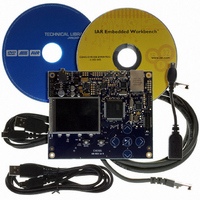ATEVK1105 Atmel, ATEVK1105 Datasheet - Page 444

ATEVK1105
Manufacturer Part Number
ATEVK1105
Description
KIT EVAL FOR AT32UC3A0
Manufacturer
Atmel
Series
AVR®32r
Type
MCUr
Datasheets
1.ATAVRONE-PROBECBL.pdf
(16 pages)
2.ATEVK1104.pdf
(826 pages)
3.ATEVK1105.pdf
(28 pages)
Specifications of ATEVK1105
Contents
Evaluation Board, Software and Documentation
Processor To Be Evaluated
AT32UC3A0512
Processor Series
AVR
Data Bus Width
32 bit
Interface Type
USART, TWI, USB, SPI, Ethernet
Operating Supply Voltage
3.3 V
Silicon Manufacturer
Atmel
Core Architecture
AVR
Core Sub-architecture
AVR UC3
Silicon Core Number
AT32UC3A0512
Silicon Family Name
AVR
Kit Contents
Board CD Docs
Rohs Compliant
Yes
For Use With/related Products
AT32UC3A0
Lead Free Status / RoHS Status
Lead free / RoHS Compliant
- Current page: 444 of 826
- Download datasheet (20Mb)
Table 29-2.
29.5.2
29.5.3
32058J–AVR32–04/11
Bit
14:11
10:0
16
15
Transmit Block
Pause Frame Support
No CRC. When set, no CRC is appended to the current frame. This bit only needs to be set for the last buffer of a frame.
Last buffer. When set, this bit indicates the last buffer in the current frame has been reached.
Reserved
Length of buffer
Transmit Buffer Descriptor Entry (Continued)
This block transmits frames in accordance with the Ethernet IEEE 802.3 CSMA/CD protocol.
Frame assembly starts by adding preamble and the start frame delimiter. Data is taken from the
transmit FIFO a word at a time. Data is transmitted least significant nibble first. If necessary,
padding is added to increase the frame length to 60 bytes. CRC is calculated as a 32-bit polyno-
mial. This is inverted and appended to the end of the frame, taking the frame length to a
minimum of 64 bytes. If the No CRC bit is set in the second word of the last buffer descriptor of a
transmit frame, neither pad nor CRC are appended.
In full-duplex mode, frames are transmitted immediately. Back-to-back frames are transmitted at
least 96 bit times apart to guarantee the interframe gap.
In half-duplex mode, the transmitter checks carrier sense. If asserted, it waits for it to de-assert
and then starts transmission after the interframe gap of 96 bit times. If the collision signal is
asserted during transmission, the transmitter transmits a jam sequence of 32 bits taken from the
data register and retries transmission after the back off time has elapsed.
The back-off time is based on an XOR of the 10 least significant bits of the data coming from the
transmit FIFO and a 10-bit pseudo random number. The number of bits used depends on the
number of collisions seen. After the first collision, 1 bit is used, after the second 2, and so on up
to 10. Above 10, all 10 bits are used. An error is indicated and no further attempts are made if 16
attempts cause collisions.
If transmit DMA underruns, bad CRC is automatically appended using the same mechanism as
jam insertion and the TX_ER signal is asserted. In a properly configured system, this should
never happen.
If the back pressure bit is set in the network control register in half duplex mode, the transmit
block transmits 64 bits of data, which can consist of 16 nibbles of 1011 or in bit-rate mode 64 1s,
whenever it sees an incoming frame to force a collision. This provides a way of implementing
flow control in half-duplex mode.
The start of an 802.3 pause frame is as follows:
Table 29-3.
The network configuration register contains a receive pause enable bit (13). If a valid pause
frame is received, the pause time register is updated with the frame’s pause time, regardless of
Destination Address
0x0180C2000001
Start of an 802.3 Pause Frame
Address
Source
6 bytes
Function
(Mac Control Frame)
0x8808
Type
Opcode
0x0001
Pause
AT32UC3A
Pause Time
2 bytes
444
Related parts for ATEVK1105
Image
Part Number
Description
Manufacturer
Datasheet
Request
R

Part Number:
Description:
DEV KIT FOR AVR/AVR32
Manufacturer:
Atmel
Datasheet:

Part Number:
Description:
INTERVAL AND WIPE/WASH WIPER CONTROL IC WITH DELAY
Manufacturer:
ATMEL Corporation
Datasheet:

Part Number:
Description:
Low-Voltage Voice-Switched IC for Hands-Free Operation
Manufacturer:
ATMEL Corporation
Datasheet:

Part Number:
Description:
MONOLITHIC INTEGRATED FEATUREPHONE CIRCUIT
Manufacturer:
ATMEL Corporation
Datasheet:

Part Number:
Description:
AM-FM Receiver IC U4255BM-M
Manufacturer:
ATMEL Corporation
Datasheet:

Part Number:
Description:
Monolithic Integrated Feature Phone Circuit
Manufacturer:
ATMEL Corporation
Datasheet:

Part Number:
Description:
Multistandard Video-IF and Quasi Parallel Sound Processing
Manufacturer:
ATMEL Corporation
Datasheet:

Part Number:
Description:
High-performance EE PLD
Manufacturer:
ATMEL Corporation
Datasheet:

Part Number:
Description:
8-bit Flash Microcontroller
Manufacturer:
ATMEL Corporation
Datasheet:

Part Number:
Description:
2-Wire Serial EEPROM
Manufacturer:
ATMEL Corporation
Datasheet:










